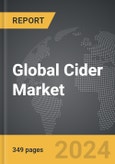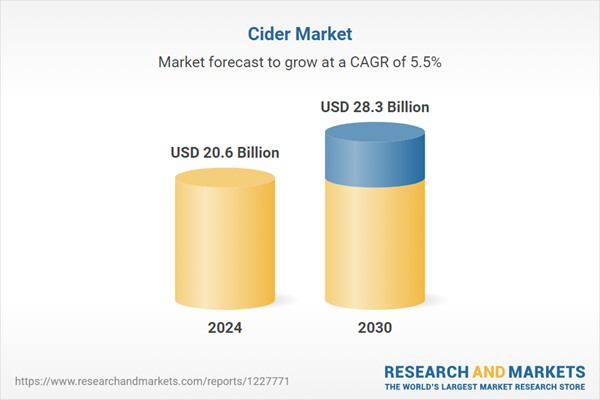The global market for Cider was valued at US$20.6 Billion in 2024 and is projected to reach US$28.3 Billion by 2030, growing at a CAGR of 5.5% from 2024 to 2030. This comprehensive report provides an in-depth analysis of market trends, drivers, and forecasts, helping you make informed business decisions. The report includes the most recent global tariff developments and how they impact the Cider market.
The modern cider market is characterized by innovation and diversification, as producers explore various methods to create distinctive and appealing products. This experimentation includes the use of different apple varieties, each imparting unique flavors and characteristics to the cider. Some producers are reviving heirloom apple varieties, which are prized for their complex flavors and historical significance. Fermentation techniques also vary, with some ciders being aged in oak barrels to add depth and complexity, while others are fermented in stainless steel tanks to preserve fresh, fruity notes. Additionally, many cider makers are infusing their products with other fruits, such as berries, pears, and citrus, to create a wider range of flavors. The rise of hard cider, with higher alcohol content than traditional cider, has also attracted younger demographic seeking new and exciting alcoholic beverages. Furthermore, the availability of gluten-free cider options caters to health-conscious consumers and those with dietary restrictions, further expanding the market's appeal.
The growth in the cider market is driven by several factors. Firstly, there is a rising consumer preference for natural and locally sourced products, which aligns with the artisanal and craft qualities of many ciders. Consumers are increasingly looking for beverages that reflect authenticity and craftsmanship, and cider fits this trend perfectly. Secondly, the increasing awareness and appreciation of cider’s versatility and diversity in flavors are attracting a broader audience. People are discovering that cider can be enjoyed in many different contexts, from casual gatherings to fine dining. Technological advancements in cider production, such as improved fermentation processes and better quality control, are enhancing product consistency and quality, making it easier for producers to meet consumer expectations. Moreover, the expanding distribution networks, both online and offline, are making cider more accessible to consumers worldwide. E-commerce platforms, specialty beverage stores, and larger retail chains are all contributing to the wider availability of cider. Additionally, the popularity of cider festivals and events is boosting consumer engagement and education about the product. These events provide opportunities for consumers to taste a variety of ciders, learn about the production process, and meet the producers. Lastly, marketing strategies that highlight the rich heritage and contemporary appeal of cider are effectively capturing consumer interest and driving market growth. These campaigns often emphasize the connection between cider and its historical roots, while also showcasing its modern, innovative aspects. Together, these factors are creating a dynamic and rapidly expanding market for cider.
Segments: Product (Apple Flavored, Fruit Flavored, Perry); Packaging (Draught, Cans, Glass Bottles, Plastic Bottles, Other Packaging).
Geographic Regions/Countries: World; United States; Canada; Japan; China; Europe (France; Germany; Italy; United Kingdom; Spain; Russia; and Rest of Europe); Asia-Pacific (Australia; India; South Korea; and Rest of Asia-Pacific); Latin America (Argentina; Brazil; Mexico; and Rest of Latin America); Middle East (Iran; Israel; Saudi Arabia; United Arab Emirates; and Rest of Middle East); and Africa.
The analysts continuously track trade developments worldwide, drawing insights from leading global economists and over 200 industry and policy institutions, including think tanks, trade organizations, and national economic advisory bodies. This intelligence is integrated into forecasting models to provide timely, data-driven analysis of emerging risks and opportunities.
Cider - Key Trends and Drivers
Cider, a fermented alcoholic beverage made from apples, boasts a rich history that spans thousands of years. Its origins can be traced to the apple-growing regions of Europe, particularly in England and France, where cider has long been a staple of local culture and cuisine. Traditionally, cider production begins by pressing apples to extract their juice. This juice is then fermented by the natural yeasts present on the apple skins, though modern producers often use cultivated yeasts to achieve consistent results. The fermentation process can vary widely, resulting in a diverse array of cider styles. These range from dry to sweet, still to sparkling, and clear to cloudy, each offering a unique taste experience. In recent years, cider has experienced resurgence in popularity, fueled by the craft beverage movement and a growing consumer interest in natural, artisanal products. This revival has brought a renewed focus on traditional methods while also encouraging innovation in the industry.The modern cider market is characterized by innovation and diversification, as producers explore various methods to create distinctive and appealing products. This experimentation includes the use of different apple varieties, each imparting unique flavors and characteristics to the cider. Some producers are reviving heirloom apple varieties, which are prized for their complex flavors and historical significance. Fermentation techniques also vary, with some ciders being aged in oak barrels to add depth and complexity, while others are fermented in stainless steel tanks to preserve fresh, fruity notes. Additionally, many cider makers are infusing their products with other fruits, such as berries, pears, and citrus, to create a wider range of flavors. The rise of hard cider, with higher alcohol content than traditional cider, has also attracted younger demographic seeking new and exciting alcoholic beverages. Furthermore, the availability of gluten-free cider options caters to health-conscious consumers and those with dietary restrictions, further expanding the market's appeal.
The growth in the cider market is driven by several factors. Firstly, there is a rising consumer preference for natural and locally sourced products, which aligns with the artisanal and craft qualities of many ciders. Consumers are increasingly looking for beverages that reflect authenticity and craftsmanship, and cider fits this trend perfectly. Secondly, the increasing awareness and appreciation of cider’s versatility and diversity in flavors are attracting a broader audience. People are discovering that cider can be enjoyed in many different contexts, from casual gatherings to fine dining. Technological advancements in cider production, such as improved fermentation processes and better quality control, are enhancing product consistency and quality, making it easier for producers to meet consumer expectations. Moreover, the expanding distribution networks, both online and offline, are making cider more accessible to consumers worldwide. E-commerce platforms, specialty beverage stores, and larger retail chains are all contributing to the wider availability of cider. Additionally, the popularity of cider festivals and events is boosting consumer engagement and education about the product. These events provide opportunities for consumers to taste a variety of ciders, learn about the production process, and meet the producers. Lastly, marketing strategies that highlight the rich heritage and contemporary appeal of cider are effectively capturing consumer interest and driving market growth. These campaigns often emphasize the connection between cider and its historical roots, while also showcasing its modern, innovative aspects. Together, these factors are creating a dynamic and rapidly expanding market for cider.
Report Scope
The report analyzes the Cider market, presented in terms of units. The analysis covers the key segments and geographic regions outlined below.Segments: Product (Apple Flavored, Fruit Flavored, Perry); Packaging (Draught, Cans, Glass Bottles, Plastic Bottles, Other Packaging).
Geographic Regions/Countries: World; United States; Canada; Japan; China; Europe (France; Germany; Italy; United Kingdom; Spain; Russia; and Rest of Europe); Asia-Pacific (Australia; India; South Korea; and Rest of Asia-Pacific); Latin America (Argentina; Brazil; Mexico; and Rest of Latin America); Middle East (Iran; Israel; Saudi Arabia; United Arab Emirates; and Rest of Middle East); and Africa.
Key Insights:
- Market Growth: Understand the significant growth trajectory of the Apple Flavored segment, which is expected to reach US$16.8 Billion by 2030 with a CAGR of a 5.1%. The Fruit Flavored segment is also set to grow at 6.1% CAGR over the analysis period.
- Regional Analysis: Gain insights into the U.S. market, valued at $5.3 Billion in 2024, and China, forecasted to grow at an impressive 8.5% CAGR to reach $6.5 Billion by 2030. Discover growth trends in other key regions, including Japan, Canada, Germany, and the Asia-Pacific.
Why You Should Buy This Report:
- Detailed Market Analysis: Access a thorough analysis of the Global Cider Market, covering all major geographic regions and market segments.
- Competitive Insights: Get an overview of the competitive landscape, including the market presence of major players across different geographies.
- Future Trends and Drivers: Understand the key trends and drivers shaping the future of the Global Cider Market.
- Actionable Insights: Benefit from actionable insights that can help you identify new revenue opportunities and make strategic business decisions.
Key Questions Answered:
- How is the Global Cider Market expected to evolve by 2030?
- What are the main drivers and restraints affecting the market?
- Which market segments will grow the most over the forecast period?
- How will market shares for different regions and segments change by 2030?
- Who are the leading players in the market, and what are their prospects?
Report Features:
- Comprehensive Market Data: Independent analysis of annual sales and market forecasts in US$ Million from 2024 to 2030.
- In-Depth Regional Analysis: Detailed insights into key markets, including the U.S., China, Japan, Canada, Europe, Asia-Pacific, Latin America, Middle East, and Africa.
- Company Profiles: Coverage of players such as Aston Manor Cider, C&C Group plc, Distell Group, Halewood International Holdings PLC, Heineken N.V. and more.
- Complimentary Updates: Receive free report updates for one year to keep you informed of the latest market developments.
Some of the 194 companies featured in this Cider market report include:
- Aston Manor Cider
- C&C Group plc
- Distell Group
- Halewood International Holdings PLC
- Heineken N.V.
- The Boston Beer Company, Inc.
Tariff Impact Analysis: Key Insights for 2025
Global tariff negotiations across 180+ countries are reshaping supply chains, costs, and competitiveness. This report reflects the latest developments as of April 2025 and incorporates forward-looking insights into the market outlook.The analysts continuously track trade developments worldwide, drawing insights from leading global economists and over 200 industry and policy institutions, including think tanks, trade organizations, and national economic advisory bodies. This intelligence is integrated into forecasting models to provide timely, data-driven analysis of emerging risks and opportunities.
What’s Included in This Edition:
- Tariff-adjusted market forecasts by region and segment
- Analysis of cost and supply chain implications by sourcing and trade exposure
- Strategic insights into geographic shifts
Buyers receive a free July 2025 update with:
- Finalized tariff impacts and new trade agreement effects
- Updated projections reflecting global sourcing and cost shifts
- Expanded country-specific coverage across the industry
Table of Contents
I. METHODOLOGYII. EXECUTIVE SUMMARY2. FOCUS ON SELECT PLAYERSIII. MARKET ANALYSISSOUTH KOREAREST OF ASIA-PACIFICARGENTINABRAZILMEXICOREST OF LATIN AMERICAIRANISRAELSAUDI ARABIAUNITED ARAB EMIRATESREST OF MIDDLE EASTIV. COMPETITION
1. MARKET OVERVIEW
3. MARKET TRENDS & DRIVERS
4. GLOBAL MARKET PERSPECTIVE
UNITED STATES
CANADA
JAPAN
CHINA
EUROPE
FRANCE
GERMANY
ITALY
UNITED KINGDOM
SPAIN
RUSSIA
REST OF EUROPE
ASIA-PACIFIC
AUSTRALIA
INDIA
LATIN AMERICA
MIDDLE EAST
AFRICA
Companies Mentioned (Partial List)
A selection of companies mentioned in this report includes, but is not limited to:
- Aston Manor Cider
- C&C Group plc
- Distell Group
- Halewood International Holdings PLC
- Heineken N.V.
- The Boston Beer Company, Inc.
Table Information
| Report Attribute | Details |
|---|---|
| No. of Pages | 349 |
| Published | April 2025 |
| Forecast Period | 2024 - 2030 |
| Estimated Market Value ( USD | $ 20.6 Billion |
| Forecasted Market Value ( USD | $ 28.3 Billion |
| Compound Annual Growth Rate | 5.5% |
| Regions Covered | Global |









